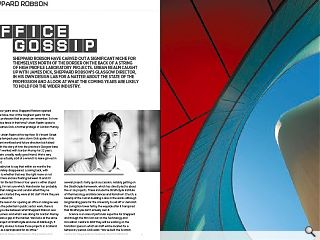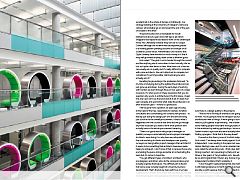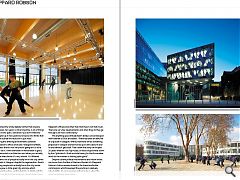Office Gossip
24 Apr 2012
Sheppard Robson have carved out a significant niche for themselves north of the border on the back of a string of high profile laboratory projects. Urban Realm caught up with James Dick, Sheppard Robson's Glasgow director, in his own design lab for a natter about the state of the profession
Greeting Urban Realm at his top floor St Vincent Street eyrie during a tempestuous rains storm Dick spoke of his studios present workload and future direction but kicked things off with the story of how the practice’s Glasgow base came to be: “I worked with Gordon Murray for 22 years. Gordon remains a really, really good friend. We’re very close, so it was actually a bit of a wrench to leave gm+ad in October 2007.
“It’s probably fair to say that within six months the market completely disappeared. Looking back, with hindsight, as to whether that was the right move or not but we’re still here and are floating between 15 and 20 staff - which for the last three or four years is either stupid or something, I’m not sure which. Manchester has probably done better than Glasgow and London albeit they’ve dropped; when I started they were at 80 staff I think they are now down to about 55.
“Part of the reason for opening an office in Glasgow was we could see the potential in public sector work, there is symmetry if you like between what Sheppard Robson was doing as a business and what I was doing for Gordon Murray. I think there was a gap in the market. We’d also at the same time won a project at Strathclyde and one at Edinburgh, it did seem pretty obvious to base those projects in Scotland and use that as a springboard for an office.”
On the back of these commissions the practice won several projects fairly quick succession, notably getting on the Strathclyde framework, which has directly led to about five or six projects. These include the Strathclyde Institute of Pharmacology and Biosciences and Ramshorn Church, a revamp of the Curran building is also in the works although longstanding plans for the University to sell off or demolish the Livingston tower fell by the wayside after it transpired that Strathclyde don’t actually own it.
Science is an area of particular expertise for Sheppard and though the firm lost out on the Technology and Innovation Centre to BDP they will be working on the transition space in which all staff will be located for a temporary period. Dick adds: “We’ve built the Scottish Centre for Regenerative Medicine, the first BREEAM excellent lab in the whole of Europe, in Edinburgh. Our virology building at the University of Glasgow’s Garscube campus will probably go on site toward the end of the year. One leads to the other.”
The practice also won a masterplan for South Dalmarnock about a year and a half ago; a job which Sheppard had hoped would lead to work on the Strathclyde Police HQ. Ultimately however they lost out to Cooper Cromar, although the scheme was subsequently placed in a holding pattern pending outcome of a merger of all Scotland’s police forces. Nevertheless Dick reckons that Clyde Gateway have invested so much money in it that it may well go ahead anyway, albeit under a different guise.
Dick noted: “They put it out to tender through the council and like anything else it came down to fees basically. We’ve lost out quite a few times on fees. Nine times out of ten we can usually win on quality but it’s really difficult to compete with some architects. We can’t afford not to compete, but sometimes it’s just impossible. Hell mend anyone who actually wins it.”
Recalling his grounding in the profession Dick said: “In my time of studying during the eighties the profession has just gone up and down. During the early days of working with Gordon we went through three or four years of a major recession, it’s when you’re in these recessions that you do question why you’re in architecture in the first place, I mean this one I just can’t see the back end of at all. It’s been four years already and god forbid what state the profession is in after those ten years – if there is a profession.
“We’ve gone from a position 20 years ago of being at the head of the tree, responsible for delivery to fellow consultants and coordinating the construction process - to literally just doing the design part of it and almost being just a bolt on to the overall procurement. If that’s what’s happened over the course of that time and we go through any more recession you hate to think what position we’ll actually have in the whole procurement hierarchy.
“There’s no good reason why project managers or quantity surveyors automatically become project managers. Architects were doing it so why have we relinquished that role and why do clients and developers see quantity surveyors as being better project managers than architects? It seems to be something that architects have been quite happy to relinquish. I don’t know if that is because those who are holding the purse strings are better at orchestrating the team but it’s not as it should be.
“You get different types of architect; architects who are designers and others who do the correspondence and actually organise themselves. The difficult part is the bit that we’re never actually taught at University, business development. That’s the bit we share with four of us here supported by London. If you share that role then you actually have time to spend overseeing projects and actually making sure there is a design quality to the projects.
“That to me is the way all architects are going to have to think. You’re going to have to relinquish your pig headed architectural view of things. If we’re going to survive we’ll need to pull together in partnership. We’ve been able to avoid making people redundant through peaks and troughs in the workload by seeking partnerships. We’re working with Gareth Hoskins right now and we’re actually talking about finding synergies. I think that is the way ahead.”
Pressed on the thorny issue of Scottish independence Dick noted: “I’ve always been totally against Scotland being independent. I was reading in the paper last weekend Alistair Darling’s view, and I’m not an Alastair Darling fan, who called the whole thing nuts. I think Alex Salmond’s timing is perfect. He’s assuming by that point we’ll have had three or four years of Tory/coalition cuts. We will probably be so anti England that if there’s any chance of getting an independent Scotland, that’s probably it.
“I also thought it quite amazing that Alex Salmond is still making reference to North Sea oil as a means to provide us with revenue, that’s just going back to 1970 when the SNP rose to popularity. But to hang your hat on one revenue source is really quite worrying. Salmond has probably pushed the whole debate further than anyone else, who knows, two years is still a long time. A lot of things can happen in two years. Somehow I just don’t think the market can pick up in two years but anyone who thinks that Scotland can outride the recession is just mad.”
Describing the differing environments between Sheppard Robson’s offices Dick said: “Glasgow’s brilliant, despite the fact there is not very much going on it’s still a great city to be in. I think Bernstein in Manchester is good, he’s really interested in architecture and when you actually spend time in Manchester it’s very vibrant. It’s different because I think a lot of people actually live in the city centre whereas I think in Glasgow, despite the regeneration, there’s not that many people who actually live in the city centre.
“But Glasgow is still a great city and one which developers and investors want to build in. In Edinburgh the only offices I can think of are Westport, Bread Street (Buro Happold’s offices) and other than that there’s not that much. There are very few developments and when they do they go through a lot more controversy.”
This anything goes attitude hasn’t always served Glasgow well however as Dick articulates: “There has been an awful lot of crap built in Glasgow. Without fail there will be something proposed in Glasgow and we’ll all be up in arms about it and lo and behold it gets built. That’s been the story for the past 20 years whether it be Tay House, or those stupid sheds down by the Clyde which I think are total lunacy for the Broomielaw which at the moment is looking quite good.”
Despite current political machinations and recent exotic successes from the likes of Siemens Masdar HQ Sheppard Robson’s future remains bound in the bread and butter commissions which have kept the practice in relatively robust fettle. An encouraging position to be in when the upturn eventually does strike.
|
|
Read next: Marlaw House
Read previous: Fife Housing Showcase
Back to April 2012
Browse Features Archive
Search
News
For more news from the industry visit our News section.
Features & Reports
For more information from the industry visit our Features & Reports section.





